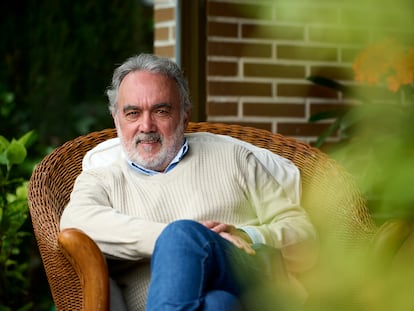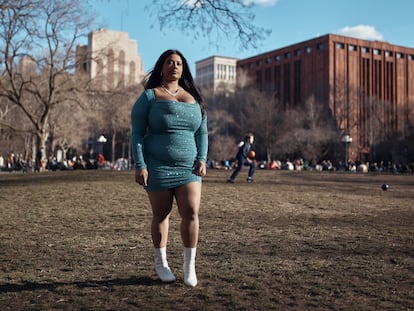Erika Lust: ‘We should stop blaming everything on porn and look at why misogyny exists’
Taking into account that pornography is the only source of information about sexuality for 30% of minors, and that mainstream content portrays violence as desirable, is positive porn possible?

Pornography has a long list of negative connotations. Experts have pointed out that the content normalizes sexual violence. Its consumption has been linked to reduced levels of empathy and increasingly risky sexual practices. Is ethical porn possible?
“We have to talk about its opposites. Conventional porn is defined by being unlimited. That type of content shows fictitious sexual relationships with bodies that are also unreal. Traditional pornography represents scenes that often eroticize the woman’s physical pain. There is data from PornHub that shows that there is so much content that just the porn consumed in 2015 could allow someone to watch porn for 15 years straight,” says Cecilia Vizzotto, a sociologist and the spokesperson of JOYclub Spain. “Before, hardcore porn was a specific type. Now practically all porn is hardcore. Consumption is more and more frequent, and children below 16 watch it every day.” A study on pornography conducted by the government of the Balearic Islands echoes her statement: 76.25% of teenage who watch porn mostly watch hardcore content, compared to 19.6% who watch content that does not show violent sexual acts.
In this context, the question arises of whether it is possible for pornography to do things right for both workers and audiences. “The content is created legally, respecting the rights and needs of workers not only in terms of decent and fair working conditions and wages, but also in terms of health and safety. There is an explicit effort to represent the diversity of bodies, practices and identities, towards inclusion and equity and self-criticism. Ethical porn directs the gaze towards desire and pleasure. But just as its production and contents are ethical, the way it is consumed should also be ethical, including the payment for its consumption and the fight against the discrimination suffered by workers,” explains Sandra Torralba, erotic artist and spokesperson for amantis.
Feminist porn: oxymoron or reality?
When talking about alternative porn, Erika Lust’s name often comes up. The filmmaker creates sex-positive adult cinema that is characterized by realistic characters and plots, focused on diversity and female pleasure. “Feminist porn originally started as a way to reclaim a genre that has traditionally been seen exclusively for men, bringing a different perspective to how we represent sex and celebrate the pleasure and sexual independence of people of all genders. Pornography made with feminist values is essentially about showing an authentic and equal representation of human sexuality without gender stereotypes,” explains Lust, who says there are many online resources and communities that encourage more positive conversations about sex and porn consumption.
Torralba points out that although many people consider porn as an institution to be patriarchal, in reality, it is those who consume and generate porn, and not the genre itself, who are sexist. “Ethical and feminist porn can be an alternative to porn that has not been shot in safe and dignified working conditions, that has not respected its workers and that has perpetuated sexual representations full of violence focused only on male pleasure,” she explains. When creating ethical porn, it is essential to talk about desire, pleasure and diversity. “That’s how I work: the performers contact me and I talk to them to see what their personal tastes are. Based on that I write the scripts, which I then send them and which are subject to changes that they can propose. The summary is to listen to the performers. I’ve seen how the mainstream works, and to me, it’s super mechanized. It’s artificial. It loses the closeness you can have with people. When I do my own productions I like it to be something else, to see how people express their sexuality. That’s what I show in the videos,” said Irina Vega, film producer, last April at the Roundtable on Ethical Porn organized by JOYclub and Amantis.
The dark side of porn
Alejandro Villena, who believes that pornography objectifies human beings and depersonalizes them, believes that feminist porn is “not a very credible label.” “There is little feminist pornography on the internet. On some sites the content is labeled that way, but quickly demeaning and macho porn appears. It’s a way for the industry to wash its face, now that issues like violence are being highlighted, but I don’t think there are real feminist ideas behind those videos. There is no pornography without consequences. If other sex education content is created in the future and reviewed by respectful professionals, it would not be pornography, it would be something else,” he says. As for lesbian porn, he adds that “it was focused from the beginning on male pleasure, so it seeks to give heterosexual men more pleasure. The more women appear, the more it encourages this fantasy, which is rooted in mens’ sexual imagination. In this lesbian porn, there is a need to go further and have more stimuli, so the so-called Coolidge effect comes into play: as you get used to something, you need more novelties. Even if the director is a woman, things don’t change. It is an exposure of intimacy and a violation of women’s rights. The fact that two women appear is not going to make those rights any less violated. It seems to me that these are simply new labels and ways of selling products, and if someone really wants to create audiovisual entertainment content, they will have to do it by the hand of sexology professionals, reviewed, with scientific effectiveness.”
According to the study on pornography in the Balearic Islands, 90% of young people consume this type of content, and three out of 10 consume it daily through the Internet. Access to pornography begins in many cases from the age of eight. The type of pornography consumed by adolescents is increasingly violent, as three out of four admit to looking for content in which women are denigrated, abused and even raped. As Villena explains in his book, of young pornography consumers, 37.5 percent of males and 19.3 percent of females were at risk of developing problematic pornography use. “Porn addiction is evident in the lack of control. We are talking about a person who is controlled by pornography, who tries to stop the behavior and is unsuccessful. In such cases, pornography is used as a regulator of emotions to regulate anxiety, stress, isolate, escape. It is used to compensate for emotions. Then there can be an impact on your sex, love, personal or work life. It takes time out of your day-to-day life,” he says.
According to Pornhub, the most viewed website in the world, people between 45 and 54 years old are the ones who consume the most porn in Spain. They account for 24% of the total. According to a study by the Fundación de Ayuda contra la Drogadicción (FAD), the first exposure to pornography typically occurs between the ages of eight and 12. It is the only source of information on sexuality for 30% of children. As Save the Children’s latest report states, more than half of adolescents say that pornography gives them ideas for their own sexual experiences.
Does porn have to be educational?
Sandra Torralba clarifies that pornography is entertainment, not sex education. While the industry defends ethical porn that is committed to both workers and audiences, she argues that encouraging critical thinking and education is not the job of the porn industry. “This role must be played by society, educational and legislative institutions, with governmental tools. Pornography, like fiction series and movies, does not necessarily reflect reality. That is why so-called porn literacy is fundamental: to train ourselves as conscious users of porn and make young people understand that pornography is not free of messages. They must learn to analyze those messages and understand that there is someone behind them. It is important that when they see an aggression towards a woman, they can detect if it is something just in that film or if it is a violence that becomes systemic, that appears in the majority of porn videos on certain platforms, and then make decisions about it,” she explains. She believes it is essential for sex education to provide tools to recognize what belongs to fantasy and what belongs to reality. Also necessary, she argues, is a legislative framework that protects workers in the industry and better regulates access to content.
Erika Lust asserts that there are many online resources and communities that encourage more positive conversations about sex and pornography consumption, which helps people become more informed and feel more confident to talk openly about their sexuality. “I don’t think it’s pornography’s responsibility to educate, but it can have the power to inspire a positive view about sex and relationships if we choose to become aware of the undercurrent of the content we view. Pornography can be a fantastic tool for self-discovery and self-exploration, as well as a tool for couple exploration. We can watch porn where people can see themselves in the movies, see the sex they’re having and be inspired by other ways of having sex,” she says. At the Roundtable on Ethical Porn, Anekke Necro, a director, explicit film performer and professional dominatrix, pointed out the importance of also looking at the class issue. “The fact that the new porn does not have violence, and that it is representative, is important, but people forget that producing better porn involves a lot of money. At the moment there is no willingness to finance porn the way any other audiovisual product is financed. People who have enormous economic capital are the people who can afford the ethics that are demanded. Many points of view are left out and many sexualities cannot be represented,” she argues.
Erika Lust reminds us that pornography is a direct mirror of the world we live in: it is not inherently harmful, nor loaded with violence and misogyny: society is.” “That’s why we need to stop blaming pornography for everything and start addressing the real problems.”
Sign up for our weekly newsletter to get more English-language news coverage from EL PAÍS USA Edition
Tu suscripción se está usando en otro dispositivo
¿Quieres añadir otro usuario a tu suscripción?
Si continúas leyendo en este dispositivo, no se podrá leer en el otro.
FlechaTu suscripción se está usando en otro dispositivo y solo puedes acceder a EL PAÍS desde un dispositivo a la vez.
Si quieres compartir tu cuenta, cambia tu suscripción a la modalidad Premium, así podrás añadir otro usuario. Cada uno accederá con su propia cuenta de email, lo que os permitirá personalizar vuestra experiencia en EL PAÍS.
¿Tienes una suscripción de empresa? Accede aquí para contratar más cuentas.
En el caso de no saber quién está usando tu cuenta, te recomendamos cambiar tu contraseña aquí.
Si decides continuar compartiendo tu cuenta, este mensaje se mostrará en tu dispositivo y en el de la otra persona que está usando tu cuenta de forma indefinida, afectando a tu experiencia de lectura. Puedes consultar aquí los términos y condiciones de la suscripción digital.
More information
Archived In
Últimas noticias
Most viewed
- Reinhard Genzel, Nobel laureate in physics: ‘One-minute videos will never give you the truth’
- Oona Chaplin: ‘I told James Cameron that I was living in a treehouse and starting a permaculture project with a friend’
- Pablo Escobar’s hippos: A serious environmental problem, 40 years on
- Why we lost the habit of sleeping in two segments and how that changed our sense of time
- Charles Dubouloz, mountaineering star, retires at 36 with a farewell tour inspired by Walter Bonatti











































